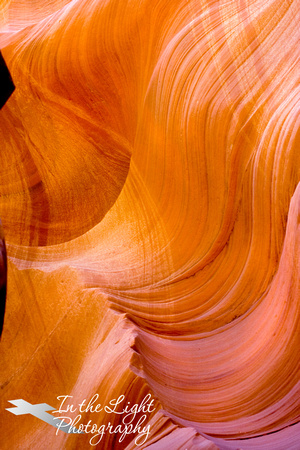SwirlingCanyonWallsCR
I took this image many years ago in Antelope Canyon near Page, Arizona. From above, the canyon looks like nothing more than a large crack in the ground. A tour guide can lead you to a slightly larger opening where you can squeeze through down to a staircase that leads deep down to the canyon floor. Some parts of the canyon are open and expansive and in other areas, you can touch the walls on both sides of you as you slide through. While in the canyon, you are greeted by curious lizards and may see a rouge tumble weed that has been caught on a high shelf of the canyon wall. The ground in covered in sand and as you look up, you can see the sun streaming in to paint the walls with bright oranges, yellows and magentas. The canyon was formed by years of erosion and pressure and is a very dangerous place to be during a monsoon. The water rushes in and fills the canyon with a force that has chiseled the sandstone to a smooth, and picturesque surface. When a storm comes, the canyon is closed due to the high danger. When we arrived there was a storm on the horizon, but it was deemed, "safe enough", which left a bit of apprehension in me. However, all the apprehension faded away as I descended into the cavernous rock and beheld the beauty that surrounded me.
………………………………………………………………………………………………….The Navajo name for Upper Antelope Canyon is Tsé bighánílíní, which means "the place where water runs through rocks." Lower Antelope Canyon is Hazdistazí (advertised as "Hasdestwazi" by the Navajo Parks and Recreation Department), or "spiral rock arches." Both are located within the LeChee Chapter of the Navajo Nation.


